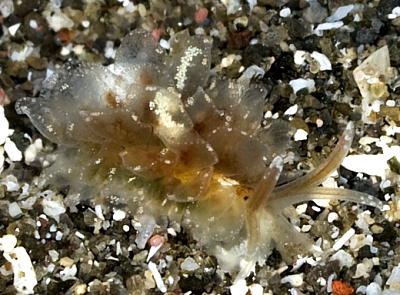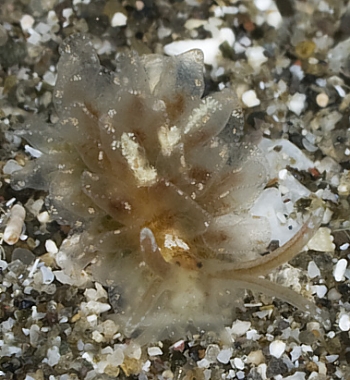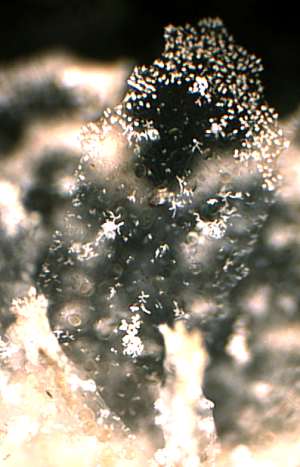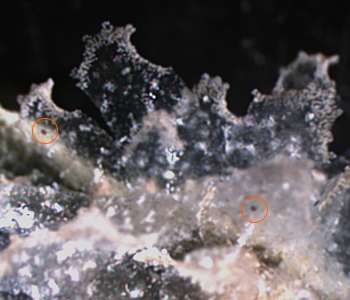
Cyerce antillensis
Engel, 1927
Order: SACOGLOSSA
Superfamily: LIMAPONTIOIDEA
Family: Caliphyllidae
DISTRIBUTION
Caribbean
PHOTO
Tarpon Springs, Gulf Coast of Florida. on Penicillus sp. approx 1cm long. Photo: S. Pierce.
The body is usually greenish in colour but sometimes may be yellow, perhaps through lack of plant material in the digestive gland. There is often white pigmentation on the dorsal surface of the body and sometimes ther can be a brownish pattern on the head. The cerata are usually transparent with some scattered white spots and often a concentration of white spots in a band along the terminal edge of each ceras, which is ornamented with a series of prominent rounded tubercles. There is often a dark spot in the midline of the ceras near the tip, and sometimes a second near the insertion point. Like all species of Cyerce it can be distinguished from species of Polybranchia and Mourgona, also found in the Caribbean, by the lack of digestive gland branches in the cerata.
Cyerce antillensis has been reported by Redfern (2001) to be found commonly in association with the green algae Penicillus dunetosus in the Bahamas. He reports it growing to at least 15mm in length.
References:
• Marcus, Er. & Marcus, Ev. (1970) Opisthobranchs from Curacao and faunistically related regions. Uitqaven van der Natuurwetenschappelijke Studiekring voor Suriname en de Nederlandse Antillen, 59: 1-129.
• Marcus, Ev. & Marcus, Er. (1963) Opisthobranchs from the Lesser Antilles. Studies on the Fauna of Curacao and other Caribbean Islands, 19(79): 1-76.
• Marcus, Ev. & Hughes, H.P.I. (1974) Opisthobranch mollusks from Barbados. Bulletin of Marine Science, 24(3): 498-532.
• Redfern. C., 2001. Bahamian Seashells: a Thousand Species from Abaco, Bahamas. Bahamianseashells.com Inc: Boca Raton, Florida. 1-280.
Rudman, W.B., 2003 (October 18) Cyerce antillensis Engel, 1927. [In] Sea Slug Forum. Australian Museum, Sydney. Available from http://www.seaslugforum.net/find/cyeranti
Related messages
Cyerce antillensis from St. Vincent
August 30, 2007
From: Linda Ianniello

Attached are two images of what I believe are Cyerce antillensis. It was found in St. Vincent (part of the Grenadines), West Indies. It was very small - found by our dive guide.
Locality: St. Vincent, 40 feet, West Indies, Caribbean, July 24, 2007, Dive site Orca II - reef. Length: approx. 1/2 inch. Photographer: Linda Ianniello.
Linda Ianniello
lindai1@bellsouth.net
Ianniello, L.M., 2007 (Aug 30) Cyerce antillensis from St. Vincent. [Message in] Sea Slug Forum. Australian Museum, Sydney. Available from http://www.seaslugforum.net/find/20551
Dear Linda,
This is a nice find, The inflated cerata and white glands along the edge of the cerata certainly fit Cyerce antillensis. Your photos show the bifurcating rhinophores very well.
Best wishes,
Bill Rudman
Re: Cyerce antillensis from Florida
October 20, 2003
From: Kathe R. Jensen
Dear Bill & Skip,
Yes this is Cyerce antillensis. If you can find enough Penicillus to keep them happy, you may be able to get babies. If I remember right they have lecithotrophic development.
Greetings,
Kathe
krjensen@zmuc.ku.dk
Jensen, K.R., 2003 (Oct 20) Re: Cyerce antillensis from Florida. [Message in] Sea Slug Forum. Australian Museum, Sydney. Available from http://www.seaslugforum.net/find/11277Thanks Kathe
Bill Rudman
Cyerce antillensis from Florida
October 19, 2003
From: Skip Pierce

Hi Bill
I've attached 3 images of a slug that we'd guess is a species of either Cyerce or Polybranchia. It appeared out of some Penicillus that my post-doc Steve Massey collected near Tarpon Springs on the Gulf Coast of Florida. It is so transparent that it is difficult to photograph and I took these through a dissecting scope, so they're pretty flat. One image is a close up of a ceras. The body of the slug is green, so it's most likely been eating the Penicillus. Also, when I was photographing it, it was crawling furiously around in the dish until I put the stalk of Penicillus in, which the slug immediately crawled to and calmed down. It has 2 sets of rhinophores (I guess both sets are rhinophores)-the longer of which (proximal pair) is divided into 2 branches at the base. The cerata are either fairly delicate or easily autotomized. The collection was about 3 weeks ago (some time in early september) and the animal is approx 1cm long. I've never seen one before, but I think it would be very difficult to find it in the field unless you were looking for it. Just for fun, Steve will try to extract some DNA from autotomized cerata and we'll see what that tells us. Any ideas about the ID??
Skip
pierce@cas.usf.edu



Dear Skip,
This is almost certainly Cyerce antillensis Engel, 1927. My first thought was a species of Mourgona, two species of which have been described from the Caribbean, but since I can't see any sign of digestive gland in the cerata then this must be a species of Cyerce. The shape of the cerata fit descriptions and drawings of C. antillensis in various Marcus publications, including the dark spot on the cerata [which I have ringed in orange alongside]. I must say Colin Redfern's (2001) comment that it is found commonly with Penicillus dumetosus removed any doubt I had.
Best wishes
Bill Rudman
